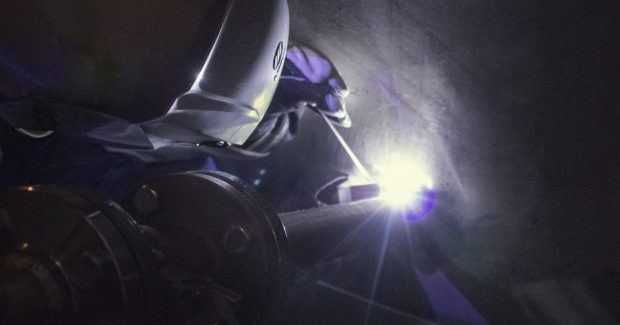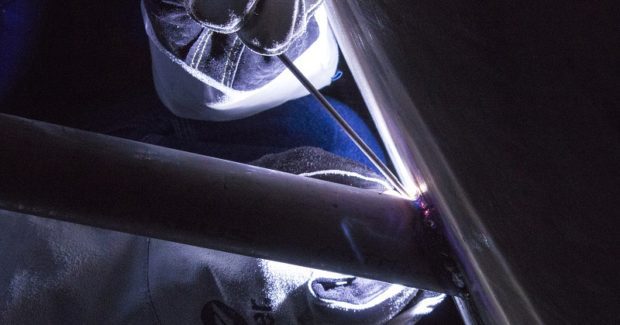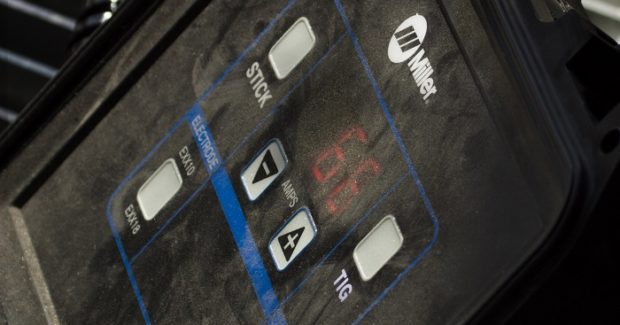Switching Polarity in Welding Applications
When competing for time-critical jobs, saving even a few minutes with each changeover can make a significant difference and reduce operator exposure to trip and fall hazards. Investing in technology that allows welders to easily change processes with the push of a button at the weld joint can save substantial time, increase weld quality and improve operator safety.
Posted: May 28, 2019
When a pipe welding application requires going from a TIG (GTAW) root pass to subsequent stick (SMAW) welding passes, the need to change the welding polarity can add a lot of time and hassle to the process. When welding carbon steel in field construction applications, such as a pipe installation, TIG welding generally uses direct current electrode negative (DCEN), while stick welding and MIG (GMAW) welding processes typically use direct current electrode positive (DCEP). Welding with an incorrect polarity for the process can contribute to poor quality and result in weld defects that may require rework. In field welding, to make a process changeover (which may also require a change in polarity), welders must trace the welding leads to find a connection point, typically at the welding power supply. The need for process changeover in a pipe application happens frequently on many welding jobsites, but what are the costs of this changeover in a typical operation?
HOURS PER DAY IN LOST PRODUCTIVITY
On some welding jobsites, this TIG-to-stick or TIG-to-MIG changeover may happen six to eight times per day for each welder. This can add up to hours every day in lost time. It’s especially time consuming on large jobsites where operators might work a great distance from their welding power source. For example, one Pennsylvania-based power plant contractor that completes major boiler outage repair projects estimates that each welding process changeover takes 30 minutes or more. There may be dozens of welders working inside a large boiler. This means a tangle of welding leads – making it harder for welders to determine which lead and machine is theirs when they want to switch processes. Contractors may even hire someone whose sole job is to manage these cables, trace leads and change processes and polarity at the power source for welders inside a boiler or other hard-to-reach spaces.
SAFETY HAZARDS
These frequent trips to the power source to change welding processes also have an impact on jobsite safety. Welders may have to climb through crawl spaces or up and down scaffolding to make the trip, which increases slip, trip and fall hazards. OSHA reports that falls were the leading cause of worker deaths in the construction industry in 2017, causing 381 out of 971 construction fatalities, or 39 percent. When welders can stay in their work area and reduce the number of trips back and forth to the power source, it results in a safer jobsite.
IMPACT ON WELD QUALITY
Welding with the proper polarity is an important part of depositing a quality weld and meeting certain code requirements. On a crowded jobsite, it’s not uncommon for a welder to accidentally change the polarity on the wrong machine. This results in frustrated welders and the potential for welds requiring rework if the operator begins welding with the wrong polarity or with incorrect parameters. The bottom line: Incorrect polarity can cost extra time and money on rework.
SIMPLIFIED POLARITY REVERSING
The common challenges for operations that frequently change welding polarities on the jobsite can be addressed with the right technology. When a welder can more easily switch between polarities and processes, hours each day in these applications can potentially be saved, improving productivity, quality and safety. Polarity reversing that is built into a welding system lets welders change processes and polarity with the push of a button using a stick/TIG remote or wire feeder. Having this control eliminates the need to walk back to the power source to swap welding cable leads in order to change processes and polarity, so welders can stay at the weld joint and achieve greater arc-on time. Polarity reversing systems can also prevent any changes from being made at the power source once the remote is connected, eliminating the chance of another welder accidentally adjusting parameters or changing processes on the wrong machine.
Having polarity reversing control built into a welding system designed for use in the field can benefit weld quality and reduce rework, while also eliminating a welder’s frustration when trying to weld with the wrong polarity. When using equipment such as our XMT® 350 FieldPro™ System with Polarity Reversing, the system will display an error and won’t let the operator weld until the lead connection is corrected – which eliminates running in the wrong polarity. The system’s tailored stick arc also reduces rework caused by frequent starts and stops. With less arc wander, the starts and stops are tailored to welding in a bevel, providing a welder with more keyhole and puddle control even when joint fit-up is inconsistent.
EASY POLARITY REVERSING
If switching between TIG, MIG and stick processes is common in your welding applications, the time spent walking back to the power source to swap the leads may be adding up to an hour or more every day per welder. This time can add up to thousands of dollars wasted by paying a welder to walk around a jobsite. Investing in technology that allows welders to easily change processes with the push of a button at the weld joint and ensures the proper polarity is used for each process offers substantial time savings in addition to benefits for weld quality and operator safety. If you’re competing for time-critical jobs, saving even a few minutes with each changeover can make a significant difference and reduce operator exposure to trip and fall hazards. If operators make seven walks across a construction site per day to make parameter and process changes, with an average of 15 minutes per walk – which equals one hour total each day – using a system with polarity reversing can help fabricators realize savings of $19,688 per year.


















